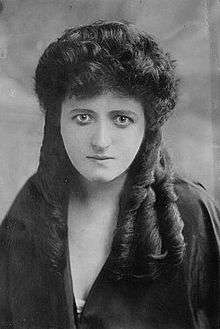Kuhne Beveridge
Kühne Beveridge (born October 31, [1874 [?], Springfield, Illinois[1][2]. [3] - ?) was an American sculptor the daughter of Phis Judson Beveridge and Ella Reutzger. [4]. She was the granddaugther of the 16th Governor of Illinois John L. Beveridge. She studied under William R. O'Donovan in New York City, and under Rodin in Paris. Among her works are a statue called "Rhodesia," "Rough Rider Monument," a statue called "Lascire," which belongs to Dr. Jameson, busts of Cecil Rhodes, King Edward VII, Grover Cleveland, Adlai Stevenson, Joseph Jefferson, Buffalo Bill, Bryan Mahon, Tom L. Johnson, and many others. Beveridge was first noticed as an artist in the US in 1892, when her busts of former President Cleveland and Mr. Jefferson called favorable attention to her. In 1893, she married Charles Francis Coghlan, and soon discovered that he had a living wife at the time of her marriage and obtained a divorce. Before she went to South Africa Beveridge had executed several commissions for Cecil Rhodes and others living in that country. Kühne received an Honorable Mention in the Paris Exposition in 1900. [5]. With the help of her mother she was also a made a statute "The Veiled Venus" for the 1900 Paris Exposition[6]which was awarded a bronze medal at the Paris Salon and was placed in Leeds Museum, England[7] Beveridge married a second time, August 25, 1903 to an American, Mr. William B. Branson, who resided at Johannesburg, in the Transvaal.[8] In 1907 she resided in London.[9]In 1910 under her maiden name she exhibited in Leipzeig Germany a sculpture of man and woman called "The Vampire" [the expliotaion of woman by man}. [10]In 1913 she was a resident of Mayfair, London England[11] In 1914 her sister Ray Beveridge, an actress, was divorced from her husband Irving Seliger.[12][13] In February 1916 Kuhne was interviewed in her Munich, Germany studio.[14] In May 1916 she was still at her Munich Studio.[15]She was listed as a surviving child in her father's May 1921 obituary.[16] In June 1930 she was selected as a member of the Illinois Hall of Fame[17]

References
- Genealogy of the Robertson, Small and Related Families: Hamilton, Livingston 1907… p.159 gives birth October 31,1874
- American Art Directory, Volume 10 1913. p.221 Gives birthdate October 31,1877
- The Anglo-African Who's who and Biographical Sketch-book p.20 lists birthdate as October 31,1878 Governors Islands, Illinois
- San Francisco Call, Volume 96, Number 18, 18 June 1904 Ella became the Countess von Wrede and died May 8, 1904
- American Art Directory, Volume 10 1913.p. 221
- Official Illustrated Catalogue, Fine Arts Exhibit, United States of America ...By U.S. Commission to the Paris Exposition, 1900
- Madera Tribune, Volume XLVI, Number 48, 26 June 1930 accessed October 15,2018
- Waters, Clara Erskine Clement (1904). Women in the Fine Arts: From the Seventh Century B.C. to the Twentieth Century A.D. (Public domain ed.). Houghton, Mifflin. pp. 43–.
- Genealogy of the Robertson, Small and Related Families: Hamilton, Livingston 1907… p.159
- The New international year book .p.653 1910
- American Art Directory, Volume 10 1913. 221
- The day book., June 05, 1914, NOON EDITION, Image 6
- Los Angeles Herald, Volume XLVI, Number 252, 22 August 1921 Ray Beveridge remarried in Germany
- Richmond times-dispatch., February 27, 1916, Image 47
- The sun., May 21, 1916, FIFTH SECTION SPECIAL FEATURE SUPPLEMENT, Page 5, Image 55
- Los Angeles Herald, Volume XLVI, Number 158, 4 May 1921 accessed October 15,2018
- Madera Tribune, Volume XLVI, Number 48, 26 June 1930 accessed October 15,2018
Bibliography
| Wikimedia Commons has media related to Kuhne Beveridge. |
